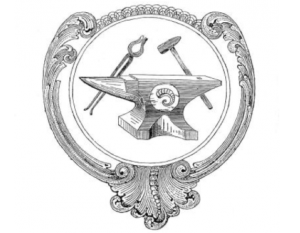Repoussé V
This is a continuing series based on the writings of the late repousse’ master, Nahum Hersom. As I have stated in other posts, I will edit by either using parenthesis, or my initials (D.N.)
Warning: The products, methods, and/or processes listed here and in other related postings, may be hazardous, and thus Bighorn Forge, Inc., or Dan Nauman will not condone using/practicing as such. These writings are simply to give you an idea as to how Nahum Hersom practiced repoussé. Lead, zinc and other metals can be hazardous to your health.
Lead Blocks
Lead, melted and poured into shapes as bench blocks, other repoussé or punch plates. Lead bench blocks are mounted on (the) rear of (the) vise. Pour lead into forms approx. 3″ x 3″ x 2″ thick, or slightly larger, 4″ x 4″ x 2-1/2″ thick.
I have a square pan made of 1/8″ plate 1/2″ larger than square of lead block, with 3/4″ sides to keep lead (block) in place. (I put) a piece of heavy truck inner tube in (the) bottom for (a) cushion. This pan has two ears welded to the side. Drill hole through the ears, (and) through the back end of (the) square vise bar, so this unit is connected to vise bar to stay in place. Be sure to taper (the) sides of (the) lead casting block pan enough so lead (block) can be removed. Blacken inside of form with carbon.
After lead (block) is removed from (the) forms, put (it) in (an) oven at about 300 degrees to anneal, especially if lead comes from auto wheel (balancing) weights.
Pure lead can be bought from non-ferrous metal companies. They have many alloys of various hardness. Plumber’s lead is soft. Pure zinc can be used to make a forming die to press soft metals into as per rubber press. Zinc or kirksite is quite hard and can be repaired with (a) torch and (a) pot metal rod, or make filler rods of zinc scrap.
By pouring lead into other forms and sizes as needed, cylinders, mushroom heads, squares, etc. that are held in (the) vise jaws, one can form smaller areas not easily done on (the) large block on (the) back of (the) vise. Also, pouring lead in back of the forms that you are working on as a back up material, will facilitate working on difficult areas, using various hand held tools, punches, veiners, etc. See repoussé pitch formulas in work book. Often, especially in reproductions, when small castings are necessary, carbon blocks or dental plaster can be used to make a form that can be filled with lead or zinc.
Stampwork
Use lead blocks to (the) size needed. I use 6″ x 6″ x 3/4″ blocks. Use on a soild surface, such as a hardwood stump. Make a frame of iron to hold (the) sheet metal firm to lead block around (the) edges. With this process, one can make stamped jewelry, medallions, etc. On some work, one can chisel cut out backgrounds which leaves the raised design. These can be riveted to another plate as per locks, etc., to have several depths showing.
(End of this installment.)
…Dan Nauman
